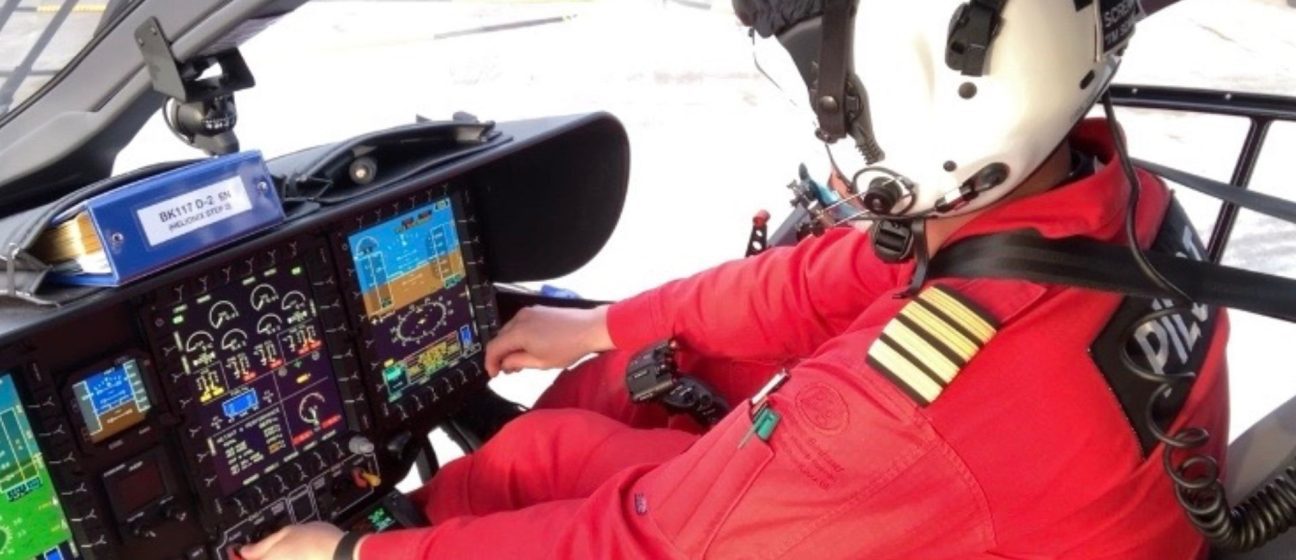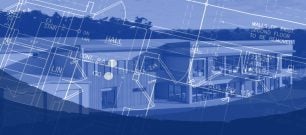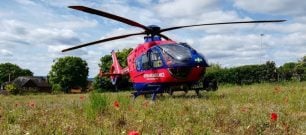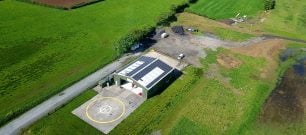
Line Pilot, Ross White, shares a typical day for him and other DAA pilots.
No two days are ever the same at Devon Air Ambulance. The weather and the incidents we attend are different hour by hour and day to day. Some things don’t change though, so I’ll give you an insight into what we do. Words: Capt. Ross White – Line Pilot
Safety first
At Exeter Airbase, our day shift starts at 7am. At Eaglescott the times change depending on the time of year. The first hour is generally the same each day. Firstly, we get changed into our flying overalls and get our helmets and the rest of our flying kit ready and load our medical kit on to the aircraft.
Then the helicopter needs a thorough check to make sure it’s safe to fly. This involves checking for leaks, oil levels, lights and anything that might not work or needs attention. A sample of the fuel is also taken from each fuel tank to make sure it’s not contaminated with debris or water. The inside of the two engines need washing everyday which means we pump fresh water through them.
The pilot will do a ground run too. A ground run is when we start the engines and the rotors and all the systems on board and do a thorough test of everything: hydraulics, fire detection circuits, autopilot, radios etc. so that we know that it’s all working correctly. While all this is being done by the pilot, the medical crew will be checking all the medical equipment and drugs.
Crew briefing
Once we know everything is in order the crew has a briefing, which covers things like the weather, which hazards there may be for aircraft (cranes, horse riding events, danger areas, etc.), the amount of fuel, spare payload and the hospitals that might not be available. This part of the day is crucial so the team knows what the constraints are and can plan for them. This takes us until about 07:45, which can be a busy time.
At Exeter, we also have another set of crew members who take over from us at 15:30. Having the second team in place means we can respond to calls until 2am. The process is very similar, but must also factor in the hours of darkness. For this our night vision goggles need to be checked and setup for each of us, and we also brief about the time of sunset, when the moon is up and which of our night time Community Landing Sites may not be available.
Ready for take off
Our shifts completely depend on what incidents we are tasked to attend. It’s rare that we don’t go out at least once a day. When the red phone rings (yes, it is red) we can hear it throughout the building.
The medics will answer the phone and get the details of the job. As pilots, the most important piece of information we need is where it is and this comes in the form of a six figure grid reference. Before the phone call has finished, we walk out to the aircraft and get it started. Within a few minutes, the rest of the crew will be in, we go through our pre-take-off checks, ask air traffic control for permission to take off and then go!
All systems go!
It’s around 3 minutes between the phone ringing and take off. In the front of the helicopter, one of the paramedics helps with the navigation and if the weather allows we will go in a straight line and other aircraft will get out of our way. If the weather is not so good, we might have to dodge around hills to get there safely and as quickly as possible.
As we travel at 140 mph we need to think ahead. Once over the location we will look for the nearest place to land, which could be a field, an empty car park or even a school playground. As long as it is safe and big enough and it has good access (not surrounded by a high fence) then it will usually be fine.
Everyone is very focused for the landing and looking out for any obstructions, such as telephone wires, masts, or people that might cause a safety issue. After landing, the medics will jump out and before the helicopter is shut down, they are off to the scene of the incident. The wonderful people of Devon are always interested in the helicopter and we are happy for people to come and have a look providing they don’t touch anything and give us and our patients space and privacy to work. We are happy to answer questions, but we also have a very important job to do.
Communication is everything
As soon as the aircraft is checked over, the pilot will start to plan which hospitals we are likely to need to attend based on the nature of the incident, as well as timings, weather constraints, fuel and aircraft weight. The back of the helicopter needs to be setup to receive the patient and we may be asked to get equipment to the medics to help them out. All the while we are communicating with them via our handheld radios.
Getting the patient to the most suitable hospital quickly and safely while delivering first-class medical care is the main objective. This means we have to be flexible, safe, plan ahead and make decisions quickly and clearly. When we get to the hospital, the patient is taken inside and we sort out the aircraft, stowing all the kit and giving it a clean so that we are ready and able to respond to the next task when required.
Glorious mud
When we are not out flying there are still things for us to do. The helicopter needs cleaning regularly, much like cleaning a car, inside and out – we often end up in muddy fields too, which gets everything dirty.
In our non-flying time we also carry out training in either aviation or medical subjects, we do our paperwork, run software updates, and undertake a dozen other tasks – while keeping an eagle eye on changes in the Devon weather.
At the end of the night shift, the helicopter is always put away inside the hangar to protect it from the elements. All our kit is put away, paperwork filed and setup ready for the next crew the following day.
Our operation is entirely funded by the kind people of Devon and beyond. You never know if or when you might need our help. Having two helicopters at immediate readiness for 19 hours a day, every day of the year is not cheap and we rely on the kindness of the Devon people to donate what they can to help us to help you.



